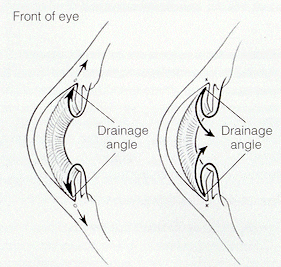
The human eye is a hollow, closed structure. The portion of the eye in front of the iris (the colored part of a person’s eye) is known as the anterior chamber (see diagram above). A clear liquid (known as aqueous humor) is formed behind the iris and travels forward into the anterior chamber. This fluid nourishes the front portion of the eye and drains out through the drainage angle. The drainage angle encircles the periphery of the anterior chamber.
Clear Liquid Called Aqueous Humor is constantly being produced within the eye (left). If the drainage angle of the eye is blocked, fluid cannot flow out of the eye (right).
During an eye exam, the depth of the anterior chamber is evaluated. When the anterior chamber is found to be shallow, the drainage angle may be narrow with the potential of being blocked. This is called a NARROW, OCCLUDABLE ANGLE. The internal pressure of the eye (intraocular pressure) is usually normal or slightly high at this point.
When a narrow drainage angle becomes blocked, the intraocular pressure becomes quickly elevated. This condition is known as ACUTE ANGLE CLOSURE GLAUCOMA. This is a true ocular emergency. When an angle closure glaucoma attack occurs, a person most likely will experience sudden vision loss and severe eye pain. If untreated, angle closure glaucoma can lead to severe, permanent loss of vision or even blindness in less than 24 hours.
When a shallow anterior chamber/narrow drainage angle is detected, a discussion with the patient takes place regarding the possibility of developing angle closure glaucoma. Depending how narrow the drainage angle is, prophylactic treatment may be indicated. A laser procedure (known as Laser Peripheral Iridotomy -LPI) may be needed to make a tiny opening in the upper part of the iris. A laser peripheral iridotomy is a painless, outpatient procedure. Performing a laser peripheral iridotomy eliminates the possibility of ever developing angle closure glaucoma. Risks, benefits and alternatives to a laser peripheral iridotomy need to be considered. The risks of the procedure are exceedingly low. The risks consist of intraocular bleeding and inflammation. Also, extraneous light entering through the new opening in the iris is possible but rare. Post-operatively, the patient should expect mild blurred vision and aching for a few hours following the procedure. The benefits consist of eliminating the possibility of developing a potentially devastating angle closure glaucoma attack.
Should you have any questions, please do not hesitate to ask Dr. Baharozian or his staff.


